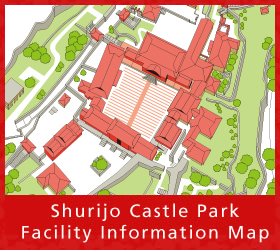“The Seven Investiture Tablets of the Sapposhi”
Home > About Shurijo Castle > Ugushiku Monogatari (Story of Shurijo Castle) > “The Seven Investiture Tablets of the Sapposhi”
Have you seen “The Seven Investiture Tablets of the Sapposhi?” These are stone monuments standing on both sides of stairs leading to the “Zuisenmon Gate,” the second gate of Shurijo Castle.
Before the Zuisenmon Gate is a spring called “Ryuhi.” “Sapposhi,” the Chinese envoys sent by the Chinese emperor, thought very highly of the water selling from this spring and read poetry or left quotes. The seven stone monuments on which those quotes have been inscribed are known as the Seven Investiture Tablets of the Sapposhi. The water of Ryuhi was also used as drinking water, etc. by the king and his family members. Since it was very delicious, the water was reportedly delivered every day to lodging facilities provided for the envoys called the Tenshikan (literally, Hall of Heavenly Envoys) near Naha Port, when the envoys were staying in the Ryukyus.
Although the Seven Investiture Tablets of the Sapposhi were destroyed during the Battle of Okinawa in 1945, they were restored using such materials as rubbed copies of the inscriptions collected around 1926.
The oldest stone monument among the seven stone monuments has the following inscription: “Chuzan Dai-ichi”(quote by Xu Baoguang, deputy investiture envoy for King Sho Kei in 1719 (Chinese era: Kangxi 58) (Fig. 1), which means “The finest spring in terms of the volume and quality of the water.” The other quotes are as shown in Table 1.
The Seven Investiture Tablets of the Sapposhi, which praise Ryuhi, are about 150 years old, but they can be thought of as a testimony that the flow of this spring has not changed. The Seven Investiture Tablets of the Sapposhi are wonderful not only as quotes but also as written texts. Why not try to appreciate these Seven Investiture Tablets of the Sapposhi while listening to the sound of the water that is constantly flowing from Ryuhi even today? (Mayumi Kuba)

| A.D. | Chinese era name | King | Position | Author of quotes | Quotes | Meaning | Figure |
|---|---|---|---|---|---|---|---|
| 1719 | Kangxi 58 | Sho Kei | Deputy envoy | Xu Baoguang | Chuzan Dai-ichi | The finest spring in the Ryukyus in terms of the volume and quality of the water. | Fig. 1 |
| 1756 | Qianlong 21 | Sho Boku | Senior envoy | Quan Kui | Unkon Sekizui | Holy and eternal water gushing out from holes in high places on the mountains | Fig. 2 |
| 1800 | Jiaqing 5 | Sho On | Senior envoy | Zhao Wenkai | Yokoku Reigen | Mystical water from east of the rising sun | Fig. 3 |
| 1808 | Jiaqing 13 | Sho Ko | Senior envoy | Qikun | Kappatsu Hatchi | A very powerful gushing spring, as lively as a jumping fish | Fig. 4 |
| 1838 | Daoguang 18 | Sho Iku | Senior envoy | Lin Hongnian | Genen Ryucho | The source of the spring is far and its flow is eternal | Fig. 5 |
| 1838 | Daoguang 18 | Sho Iku | Deputy envoy | Gao Renjian | Hisen Sogyoku | A clear spring whose water leaps and scatters like gems | Fig. 6 |
| 1866 | Tongzhi 5 | Sho Tai | Senior envoy | Zhao Xin | Reimyaku Ryufun | A very fragrant flow from an ethereal vein of water | Fig. 7 |
© Shurijo Castle Park All Rights Reserved.









